How to load dishes into a Midea dishwasher
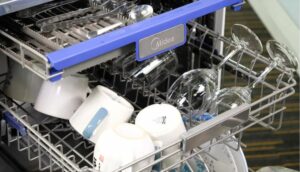 Housewives often don't even realize how important it is to load dishes correctly. The fact is that improper loading of tableware can not only provoke poor-quality washing, due to which the dishes will remain dirty after the working cycle, but can also damage the “home assistant”. To prevent this from happening, we have prepared for you detailed material on the correct placement of dishes in the dishwasher.
Housewives often don't even realize how important it is to load dishes correctly. The fact is that improper loading of tableware can not only provoke poor-quality washing, due to which the dishes will remain dirty after the working cycle, but can also damage the “home assistant”. To prevent this from happening, we have prepared for you detailed material on the correct placement of dishes in the dishwasher.
Let's pay attention to the dishes
The first step to starting loading dishes correctly is to prep your cutlery. In other words, cleaning utensils from leftover food and other debris. Pieces of food, leftover legumes and corn, pits from fruits and berries, tea bags, coffee grounds, napkins and toothpicks - all this must be removed from the dishes before loading them into the washing chamber of the Midea dishwasher. Remember that the more thoroughly you remove all excess debris and contaminants using wet wipes, sponges or any other available items, the better the work cycle will be, and the less chance there will be of clogging of the garbage filter, as well as the PMM drain system.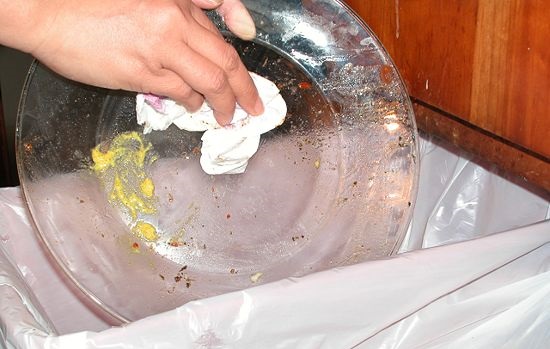
With pre-rinsing, everything is not so simple. On the one hand, why manually rinse dishes and wet your hands every time if you have a Midea dishwasher at home? However, this really makes sense if you have been accumulating dirty dishes for a long time, the remains of food and grease on which have time to dry in a few days or even a week.If you wash dishes immediately after eating, then preliminary hand rinsing is not necessary, so cutlery can be immediately placed in baskets inside the washing chamber. Finally, in conditions where you accumulate dirty dishes during the day, immediately placing them in the PMM to wash everything at once in the evening, you can activate the pre-rinse so as not to get your hands dirty by removing and adding dishes back to the baskets.
Where to put glasses and wine glasses?
We've sorted out the preparation for the work cycle, now it's time to move on to the dishes themselves and their location inside the Midea dishwasher. Glasses, mugs and cups often simply do not know where to place them, so they are piled up on other dishes, which is under no circumstances allowed to be done. In most PMM models, an upper tray has been created for this type of dishware, in which the vessels should be placed upside down so that water gets into them, washes them thoroughly, and then flows down unhindered. These cutlery items cannot be placed horizontally, because this way almost no liquid will get inside.
Each cutlery must stand firmly so that it is not knocked over by a powerful jet of water during operation.
As for wine glasses and fragile glasses, they usually have a special holder in which they need to be secured with the stem up. Be sure to ensure that fragile glassware does not touch each other to prevent the glass from cracking during the operating cycle. However, remember that the plastic holder can also be used for small cups, for which it is also perfect.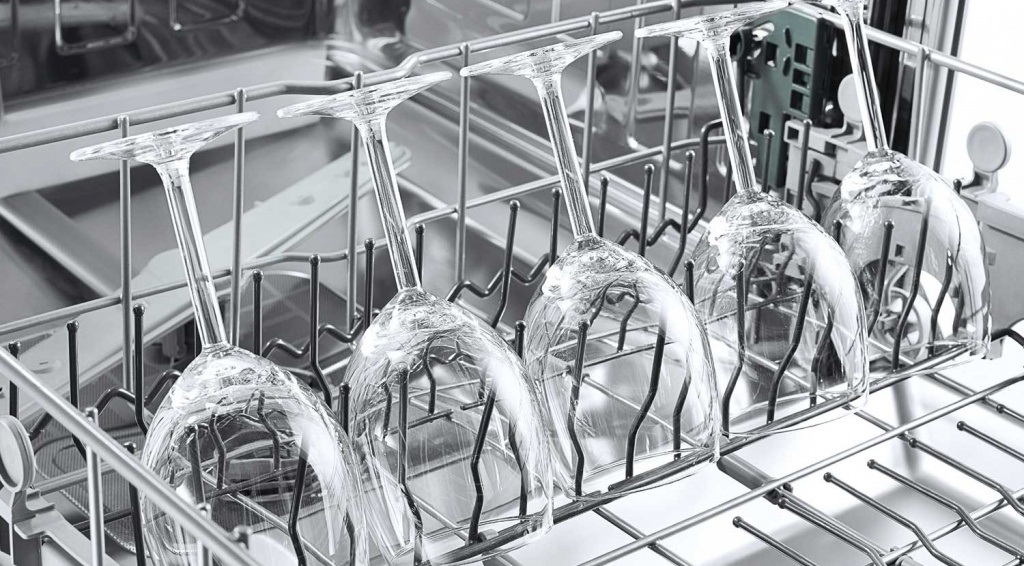
Place saucers and bowls
We smoothly move on to the main section - plates, saucers, bowls and other similar tableware.If you have enough space inside the washing chamber, then on the top tray you should place:
- small braids;
- bowls;
- bowls;
- saucers;
- gravy boats;
- spice jars.

If you wish, you can also place plastic dishes on top, but in this case you should choose gentle operating modes that do not heat the water very much. Plus, plastic utensils should not be placed near the heating element, otherwise they may melt and get on both other cutlery and key components of the Midea dishwasher.
The lower tray is intended for larger items, for example, for plates for main courses. Be sure to place the largest plates at the edges, leaving the center of the basket for plates with a small diameter - this will allow the water from the sprinklers to better wash the cutlery, both in the lower and upper tray. It is also very important to place the plates facing the center of the Midea PMM so that they do not touch each other. Also keep in mind that there must be at least a minimum gap between each item so that water has access to the entire surface of the dish.
Where to put spoons and forks?
Here is the last item of daily dishwashing - forks and spoons. Midea dishwashers usually have a special basket for the smallest cutlery items. In it you can freely arrange forks, spoons and knives, alternating them with each other and leaving a small gap between the items. Knives made of ceramics and with wooden handles, which are not recommended to be washed in dishwashers, deserve special attention. The former may become dull, and the latter may become unusable due to the fact that the wood simply swells in water.
Be sure to place knives with the blades facing down to avoid accidental injury when removing dishes after finishing washing.
Please note that in the newest Midea PMMs, tableware must be placed in the topmost tray. The manufacturer expects that in this case, the user will place not only knives horizontally, but also spoons and forks, due to which not only the quality of washing dishes will improve, but there will also be much more space inside the washing chamber, compared to standard “household aids”.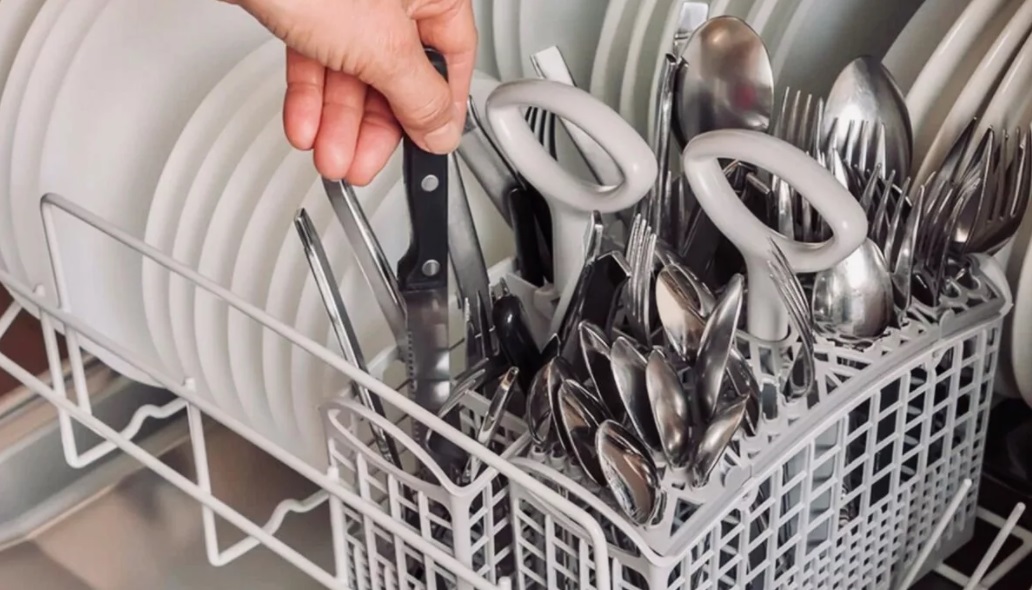
How to wash large items?
We only have to sort out the largest types of utensils, which are used for preparing food for the whole family, for guests, holidays, and so on. Large frying pans, large pots, saucepans, baking sheets, etc. must be placed in the lower tray, placed separately from glass, porcelain, crystal and other fragile items that may not withstand intensive washing at maximum temperatures. 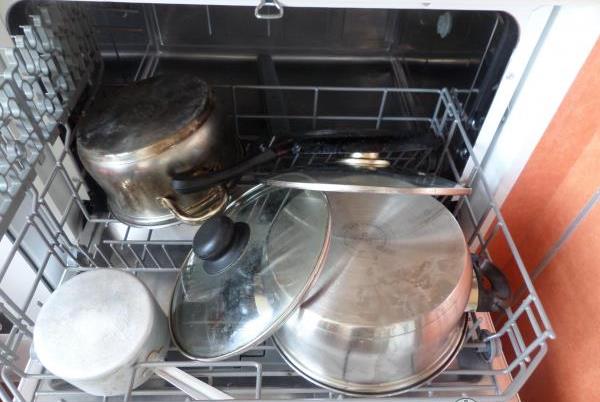
Place pans and baking sheets on their sides so that they do not interfere with the free movement of the spray arms. Place the pots upside down or sideways so that water does not pool in them.
Before loading dishes, be sure to study the information about the coating of a particular tableware, so as not to accidentally wash Teflon-coated dishes or other items in the PMM that are prohibited from being cleaned in a Midea dishwasher.
If you can remove the handle from your saucepans or frying pans, then you should remove it before the work cycle, but if it cannot be removed, then make sure that it does not touch the walls of the washing chamber. Finally, don't forget about the half-load mode for situations when you don't have a lot of dishes, but you definitely need to wash them - this will clean dirty dishes and save water and electricity.
Recommendations for placing items in PMM
Finally, let’s look at a number of rules that will help you load dishes into the PMM correctly. Never overload household appliances, because this will directly affect both the quality of washing and electricity consumption. Study the official instructions to find out the maximum number of dirty dishware sets that can be placed in the unit. If you have a small Midea dishwasher, then it can wash up to 6 sets of dishes at a time, if it’s narrow, then up to 11, and in the case of a full-size one, up to 17 pieces.
But you shouldn’t always focus only on the number of sets, because all the dishes differ in size from each other. A set consisting of soup bowls is not the same as a tea set with small saucers for desserts, so take this into account when using the “home assistant”. As for the final tips for housewives, they are as follows:
- watch for overload and do not allow it, because it is better to split the wash into two different cycles than to wash everything poorly at one time;
- always examine your dishes to see if they can be washed in the Midea PMM;
- do not allow the dishes to touch each other;
- It is better not to wash heavily soiled items such as frying pans together with lightly soiled items such as mugs or glasses;
- do not wash wooden dishes so that they do not deteriorate after cleaning;

- If you are used to collecting dishes all day and washing them in the evening, then immediately place the items in the machine so that they do not dry out and can be easily washed.
At first glance, it may seem that loading dishes correctly is some kind of complex art that is difficult to master. But if the first download can take you up to half an hour, then with experience the process will begin to take no more than 5-10 minutes.
Interesting:
Reader comments
- Share your opinion - leave a comment
Categories
Washing machine repair


For buyers

For users

Dishwasher


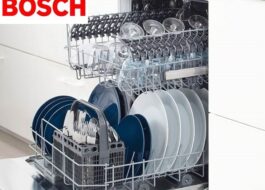

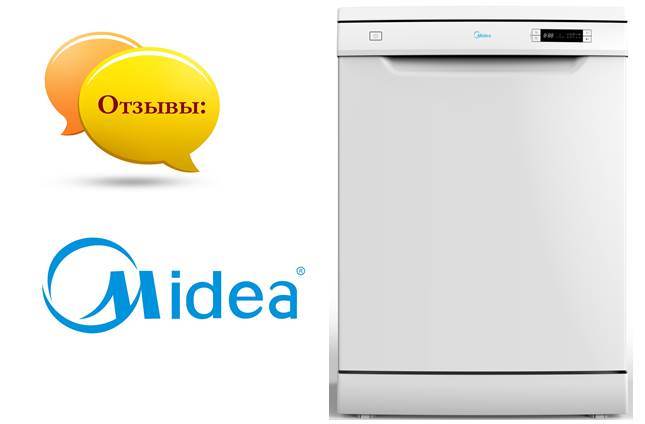












Add a comment